UAV Array-Aided Visible Light Communication with Enhanced Angle Diversity Transmitter
Abstract
1. Introduction
2. System Model
2.1. The Structure of the Enhanced ADT
2.2. Optical Channel Gain
2.3. Energy Efficiency
3. Simulation Results
3.1. The Centralized Single-UAV Configuration
3.2. The Distributed UAV-Array Configuration
4. Conclusions
Author Contributions
Funding
Data Availability Statement
Conflicts of Interest
References
- Saad, W.; Bennis, M.; Chen, M. A vision of 6G wireless systems: Applications, trends, technologies, and open research problems. IEEE Netw. 2020, 34, 134–142. [Google Scholar] [CrossRef]
- Dai, H.; Zhang, H.; Hua, M.; Li, C.; Huang, Y.; Wang, B. How to deploy multiple UAVs for providing communication service in an unknown region? IEEE Wirel. Commun. Lett. 2019, 8, 1276–1279. [Google Scholar] [CrossRef]
- Mozaffari, M.; Saad, W.; Bennis, M.; Nam, Y.H.; Debbah, M. A tutorial on UAVs for wireless networks: Applications, challenges, and open problems. IEEE Commun. Surv. Tuts. 2019, 21, 2334–2360. [Google Scholar] [CrossRef]
- Khan, L.U. Visible light communication: Applications, architecture, standardization and research challenges. Digit. Commun. Netw. 2017, 3, 78–88. [Google Scholar] [CrossRef]
- Dabiri, M.T.; Sadough, S.M.S.; Khalighi, M.A. Channel modeling and parameter optimization for hovering UAV-based free-space optical links. IEEE J. Sel. Areas Commun. 2018, 36, 2104–2113. [Google Scholar] [CrossRef]
- Eltokhey, M.W.; Khalighi, M.A.; Ghassemlooy, Z. UAV location optimization in MISO ZF pre-coded VLC networks. IEEE Wirel. Commun. Lett. 2021, 11, 28–32. [Google Scholar] [CrossRef]
- Cang, Y.; Chen, M.; Zhao, J.; Yang, Z.; Hu, Y.; Huang, C.; Wong, K.K. Joint deployment and resource management for VLC-enabled RISs-assisted UAV networks. IEEE Trans. Wirel. Commun. 2022, 22, 746–760. [Google Scholar] [CrossRef]
- Maleki, M.R.; Mili, M.R.; Javan, M.R.; Mokari, N.; Jorswieck, E.A. Multi-agent reinforcement learning trajectory design and two-stage resource management in CoMP UAV VLC networks. IEEE Trans. Commun. 2022, 70, 7464–7476. [Google Scholar] [CrossRef]
- Yu, T.C.; Huang, W.T.; Lee, W.B.; Chow, C.W.; Chang, S.W.; Kuo, H.C. Visible Light Communication System Technology Review: Devices, Architectures, and Applications. Crystals 2021, 11, 1098. [Google Scholar] [CrossRef]
- Cevik, T.; Yilmaz, S. AN overview of visible light communication systems. Int. J. Comput. Netw. Commun. 2015, 7, 139–150. [Google Scholar] [CrossRef]
- Ma, H.; Lampe, L.; Hranilovic, S. Hybrid visible light and power line communication for indoor multiuser downlink. J. Opt. Commun. Netw. 2017, 9, 635–647. [Google Scholar] [CrossRef]
- Oyewobi, S.S.; Djouani, K.; Kurien, A.M. Visible light communications for internet of things: Prospects and approaches, challenges, solutions and future directions. Technologies 2022, 10, 28. [Google Scholar] [CrossRef]
- Komine, T.; Nakagawa, M. Fundamental analysis for visible-light communication system using LED lights. IEEE Trans. Consum. Electron. 2004, 50, 100–107. [Google Scholar] [CrossRef]
- Baiocchi, V.; Dominici, D.; Mormile, M. UAV application in post-seismic environment. Int. Arch. Photogramm. Remote. Sens. Spat. Inf. Sci. 2013, 1, W2. [Google Scholar] [CrossRef]
- Mersheeva, V.; Friedrich, G. Multi-UAV monitoring with priorities and limited energy resources. In Proceedings of the International Conference on Automated Planning and Scheduling, Jerusalem, Israel, 7–11 June 2015; Volume 25, pp. 347–355. [Google Scholar]
- Pham, Q.V.; Huynh-The, T.; Alazab, M.; Zhao, J.; Hwang, W.J. Sum-rate maximization for UAV-assisted visible light communications using NOMA: Swarm intelligence meets machine learning. IEEE Int. Things J. 2020, 7, 10375–10387. [Google Scholar] [CrossRef]
- Wang, Y.; Chen, M.; Yang, Z.; Luo, T.; Saad, W. Deep learning for optimal deployment of UAVs with visible light communications. IEEE Trans. Wirel. Commun. 2020, 19, 7049–7063. [Google Scholar] [CrossRef]
- Yun, W.J.; Park, S.; Kim, J.; Shin, M.; Jung, S.; Mohaisen, D.A.; Kim, J.H. Cooperative multiagent deep reinforcement learning for reliable surveillance via autonomous multi-UAV control. IEEE Trans. Ind. Inf. 2022, 18, 7086–7096. [Google Scholar] [CrossRef]
- Nuwanpriya, A.; Ho, S.W.; Chen, C.S. Indoor MIMO visible light communications: Novel angle diversity receivers for mobile user. IEEE J. Sel. Areas Commun. 2015, 33, 1780–1792. [Google Scholar] [CrossRef]
- Chen, C.; Zhong, W.D.; Yang, H.; Zhang, S.; Du, P. Reduction of SINR fluctuation in indoor multi-cell VLC systems using optimized angle diversity receiver. J. Lightw. Technol. 2018, 36, 3603–3610. [Google Scholar] [CrossRef]
- Zeng, Z.; Chen, C.; Wu, X.; Savović, S.; Soltani, M.D.; Safari, M.; Haas, H. Interference mitigation using optimised angle diversity receiver in LiFi cellular network. Opt. Commun. 2025, 574, 131125. [Google Scholar] [CrossRef]
- Al-Sakkaf, A.G.A.; Morales-Céspedes, M. Interference Management for VLC Indoor Systems Based on Overlapping Field-of-View Angle Diversity Receivers. IEEE Access 2024, 12, 51431–51449. [Google Scholar] [CrossRef]
- Chatterjee, S.; Sabui, D.; Roy, B. Mobility aware blockage management of a multi-user multi-cell hybrid Li-Fi Wi-Fi system with freeform diversity receiver. Opt. Commun. 2024, 560, 130487. [Google Scholar] [CrossRef]
- Zeng, Z.; Soltani, M.D.; Safari, M.; Haas, H. A VCSEL array transmission system with novel beam activation mechanisms. IEEE Trans. Commun. 2022, 70, 1886–1900. [Google Scholar] [CrossRef]
- Huang, Q.; Wen, W.; Liu, M.; Du, P.; Chen, C. Energy-efficient unmanned aerial vehicle-aided visible light communication with an angle diversity transmitter for joint emergency illumination and communication. Sensors 2023, 23, 7886. [Google Scholar] [CrossRef] [PubMed]
- Wang, J.B.; Hu, Q.S.; Wang, J.; Chen, M.; Wang, J.Y. Tight bounds on channel capacity for dimmable visible light communications. J. Lightw. Technol. 2013, 31, 3771–3779. [Google Scholar] [CrossRef]
- Yang, Y.; Chen, M.; Guo, C.; Feng, C.; Saad, W. Power efficient visible light communication with unmanned aerial vehicles. IEEE Commun. Lett. 2019, 23, 1272–1275. [Google Scholar] [CrossRef]
- Pathak, P.H.; Feng, X.; Hu, P.; Mohapatra, P. Visible light communication, networking, and sensing: A survey, potential and challenges. IEEE Commun. Surveys Tuts. 2015, 17, 2047–2077. [Google Scholar] [CrossRef]

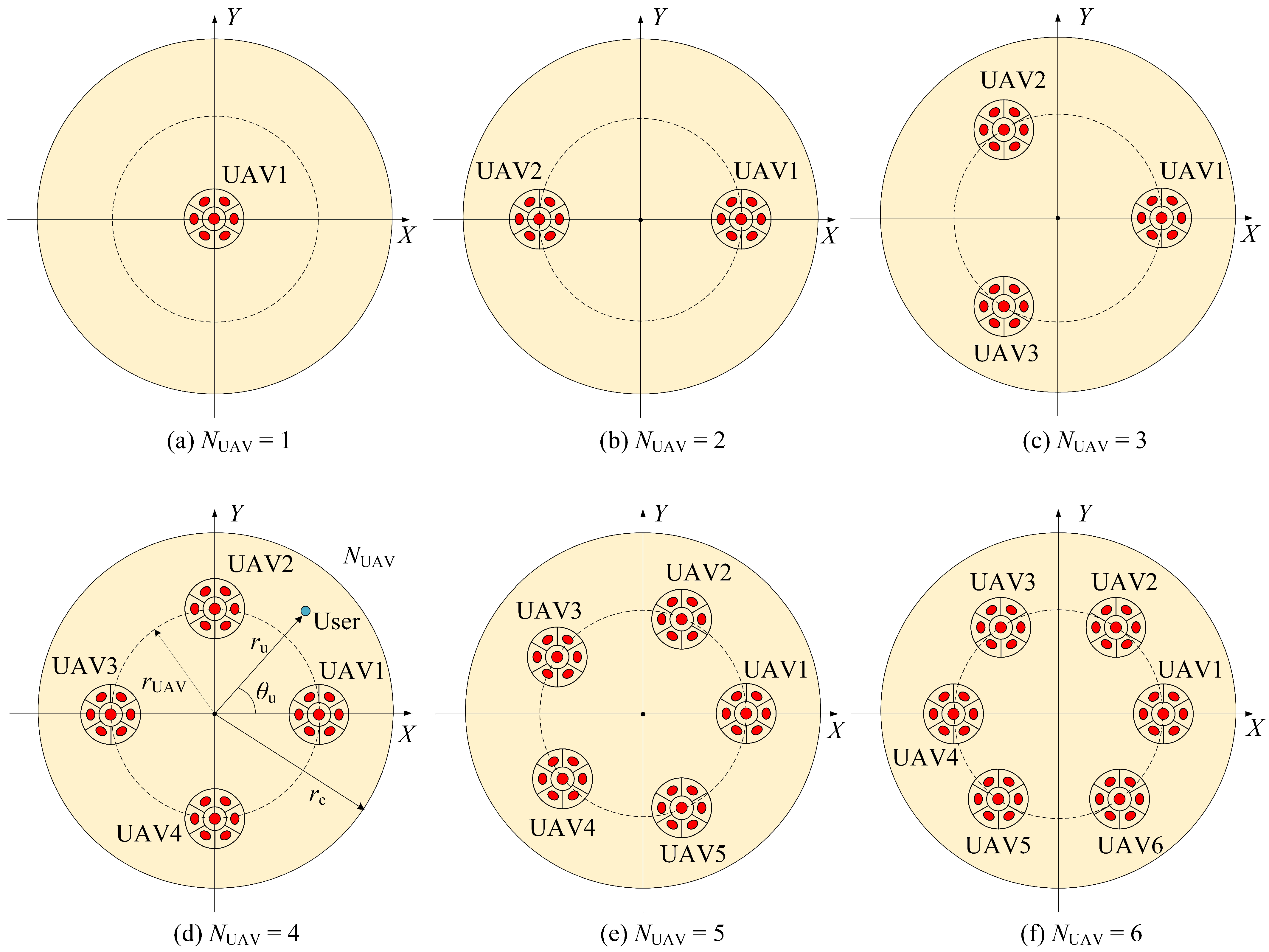
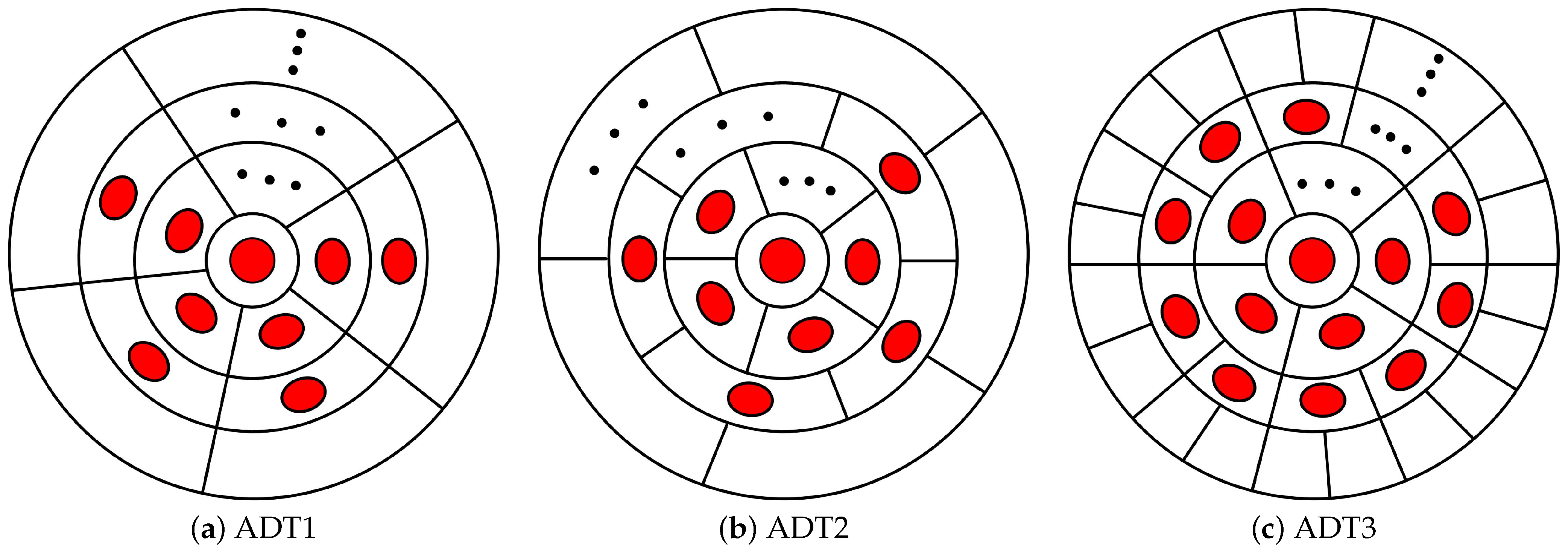


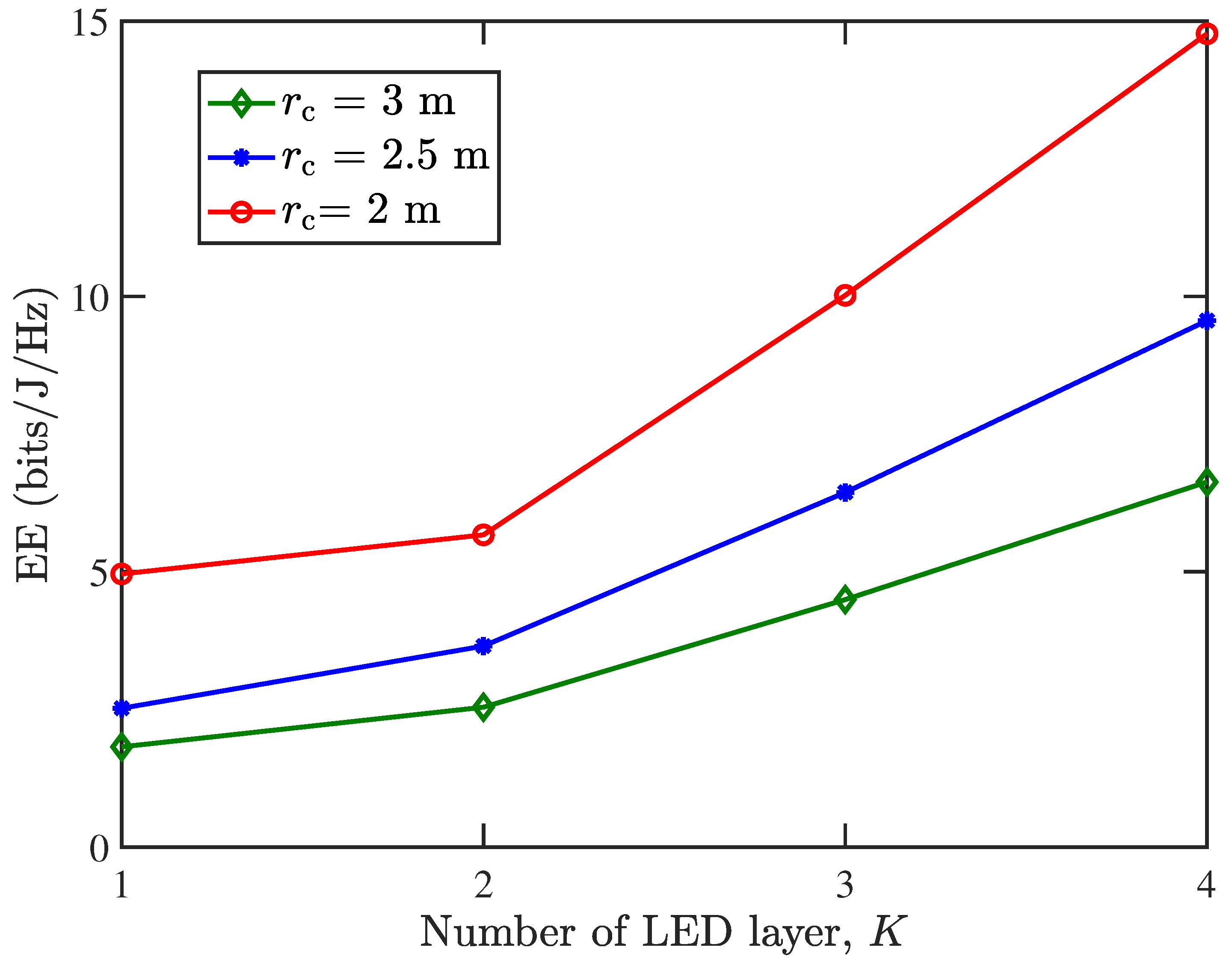
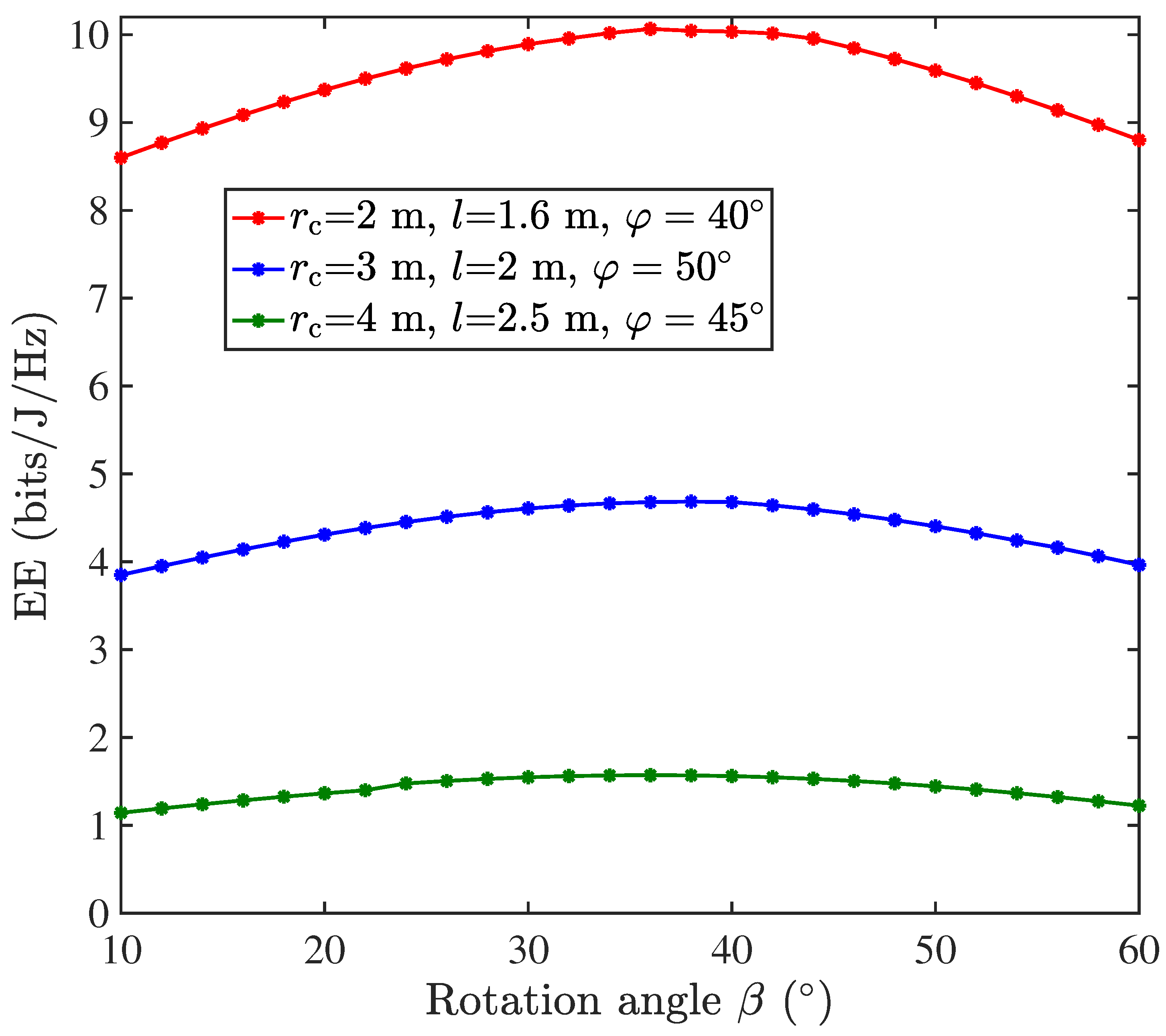
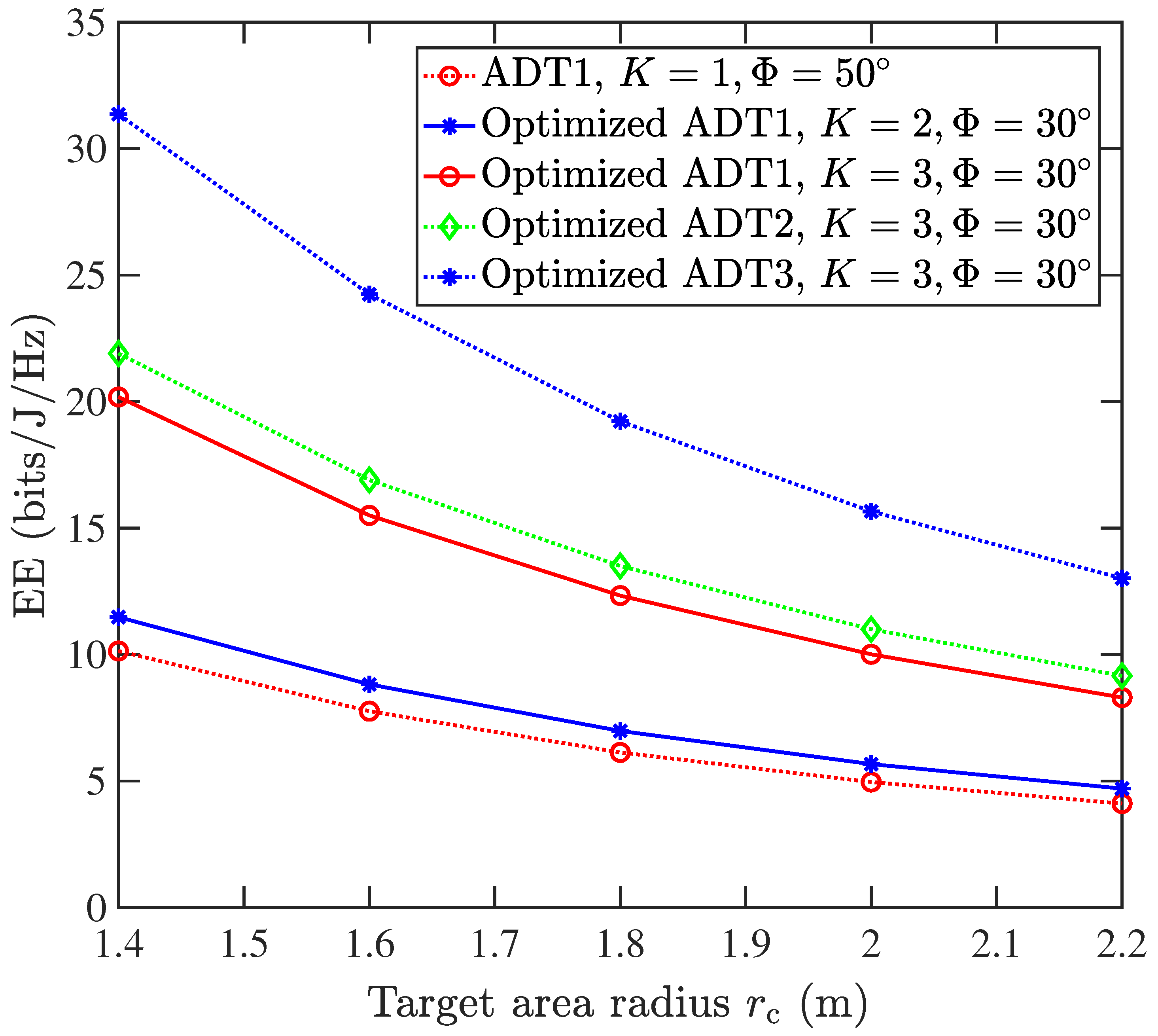

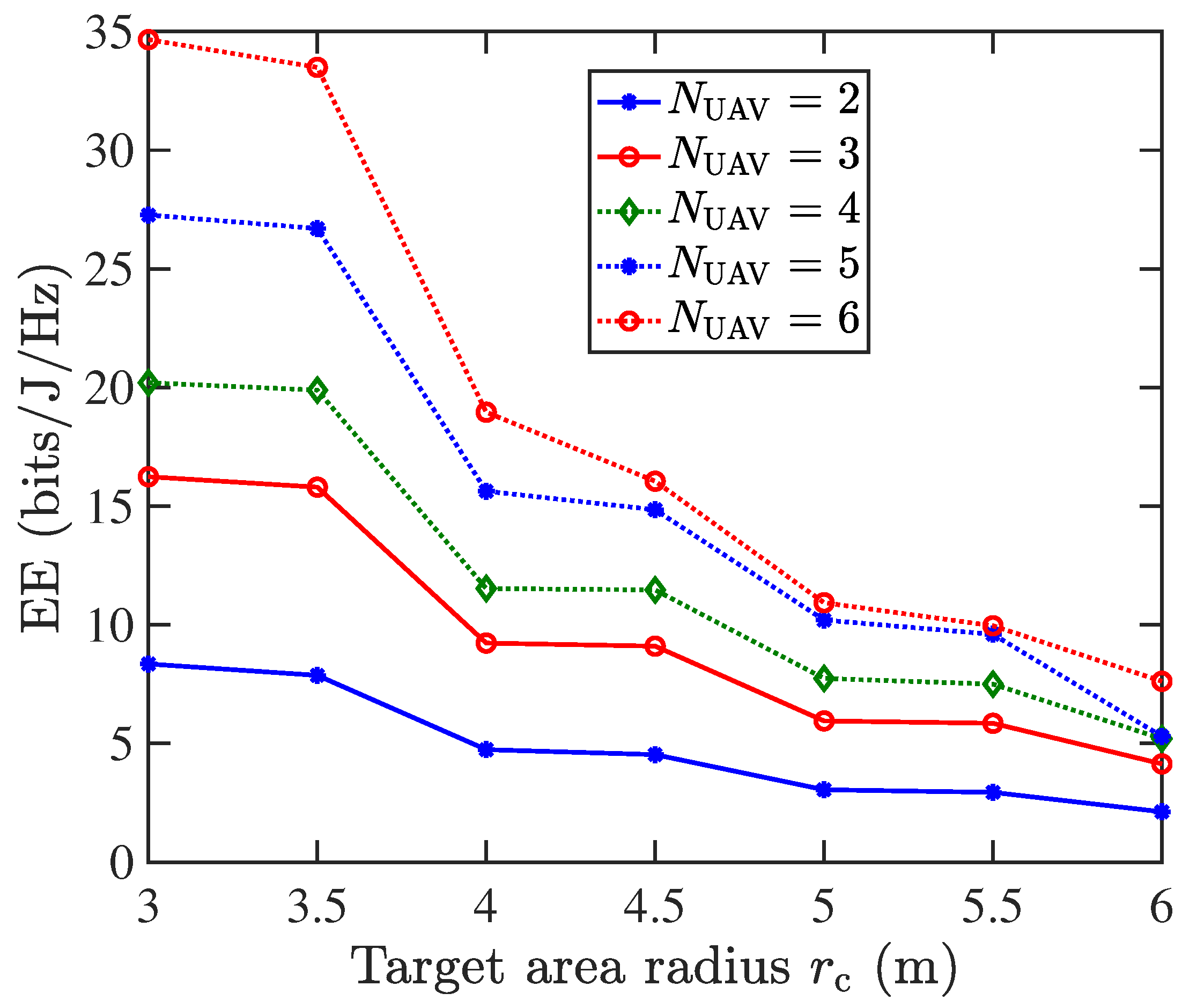
| Parameter | Value |
|---|---|
| Gain of filter | 0.9 |
| FOV of optical concentrator | |
| Refractive index of optical concentrator n | 1.5 |
| Active receiving area of PD A | 1 cm2 |
| Noise PSD | A2/Hz |
| Photoelectric conversion coefficient | 1 W/A |
| Responsivity | 0.8 A/W |
| Signal bandwidth | 10 MHz |
| Semi-angle at half power of the LED | |
| Channel capacity threshold | 1 bit/s/Hz |
| Illuminance threshold | Lx |
Disclaimer/Publisher’s Note: The statements, opinions and data contained in all publications are solely those of the individual author(s) and contributor(s) and not of MDPI and/or the editor(s). MDPI and/or the editor(s) disclaim responsibility for any injury to people or property resulting from any ideas, methods, instructions or products referred to in the content. |
© 2025 by the authors. Licensee MDPI, Basel, Switzerland. This article is an open access article distributed under the terms and conditions of the Creative Commons Attribution (CC BY) license (https://creativecommons.org/licenses/by/4.0/).
Share and Cite
Wang, W.; Zeng, Z.; Chen, C.; Wang, D.; Liu, M.; Haas, H. UAV Array-Aided Visible Light Communication with Enhanced Angle Diversity Transmitter. Sensors 2025, 25, 5752. https://doi.org/10.3390/s25185752
Wang W, Zeng Z, Chen C, Wang D, Liu M, Haas H. UAV Array-Aided Visible Light Communication with Enhanced Angle Diversity Transmitter. Sensors. 2025; 25(18):5752. https://doi.org/10.3390/s25185752
Chicago/Turabian StyleWang, Weiren, Zhihong Zeng, Chen Chen, Dengke Wang, Min Liu, and Harald Haas. 2025. "UAV Array-Aided Visible Light Communication with Enhanced Angle Diversity Transmitter" Sensors 25, no. 18: 5752. https://doi.org/10.3390/s25185752
APA StyleWang, W., Zeng, Z., Chen, C., Wang, D., Liu, M., & Haas, H. (2025). UAV Array-Aided Visible Light Communication with Enhanced Angle Diversity Transmitter. Sensors, 25(18), 5752. https://doi.org/10.3390/s25185752






